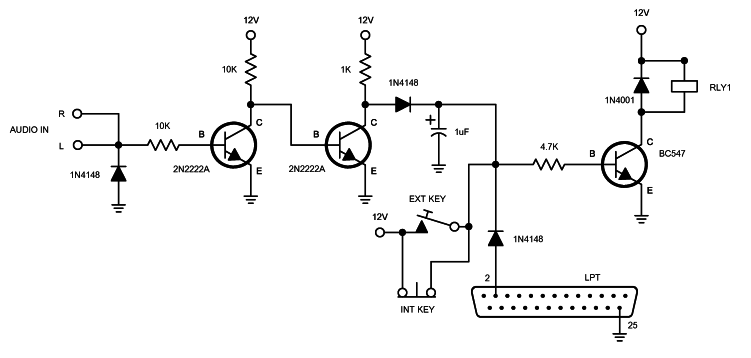
by SV3ORA
Control the transmitter from the
computer

by SV3ORA

The transmitter control circuit shown here can control the transmitter in 3 different ways. A transistor performs electronic keying to the transmitter and it keys RLY1. There are three transmitter control options here, manual control, computer control and audio control. Manual control refers to the standard morse code key, which passes 12V to the base of the transistor, through the limiter resistor. I have chosen to use the LPT port of the computer as an interface to the transmitter because I can control data bits easier than the serial port. For the keying, we need only one bit, so the first data pin of the LPT port was used. A 1N4148 diode protects the LPT port from accidentally pressing the manual key down and feed the LPT pin with 12V.
Many modern laptops do not have an LPT port (some of them not even a COM port) and rely on the USB ports to control everything. In my opinion, a computer without serial and parallel ports is unacceptable for radio amateur use but it you already have one, I have included a circuit that controls the transmitter using the audio output of the sound blaster. Also, this has the advantage that you can use software that only outputs signal to the sound blaster and does not support the LPT port. The audio interface is capable of driving the transmitter from the line output of the computer at about half the audio volume setting of the sound blaster and above. I have tested all the audio tones from below 100Hz up to 3KHz and the interface works fine.
When I go mobile, I do not want to carry the big and bulky key with me, so I added another internal key which can be attached to the front panel of the transmitter in a place that you could easily access. It is just a momentary switch that is connected in parallel to the external key socket. Of course you could not expect the same settings and convenience like the external key but it is small, lightweight and attached on the transmitter.
If you want to combine this circuit with a receiver, so you can use your sound blaster for receiving too, then you can add another relay at the input that switches the audio between this circuit and the receiver. This relay can be controlled using the PTT key. But a possible easiest and cheapest way would be to use only the right channel of your stereo sound blaster to control this circuit and then use the remaining left channel for receiving purposes. Just connect the left channel to your receiver.
You can use this controller without a relay to control your transmitter too. Just remove the diode and the relay from the BC547 collector and connect the transmitter power there. The one lead of the transmitter goes to 12V and the other to the collector of the transistor. If you want to control a greater load use a more powerful transistor, or better use the BC547 transistor to control a more powerful transistor, which in turn controls the transmitter.